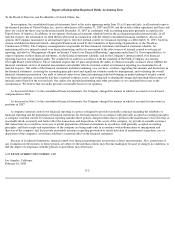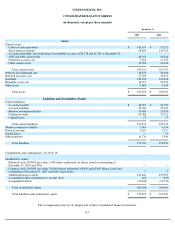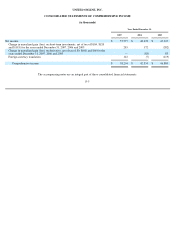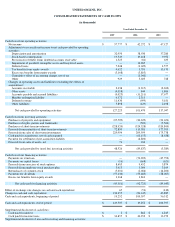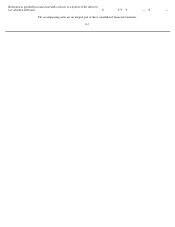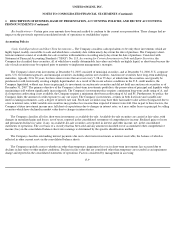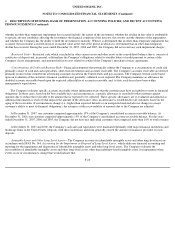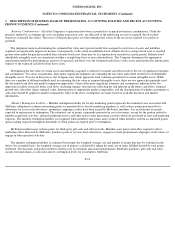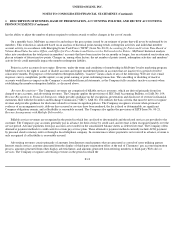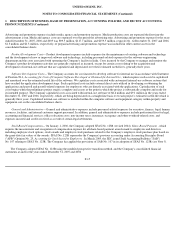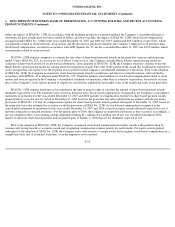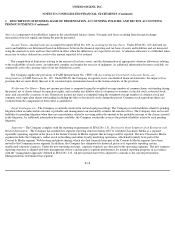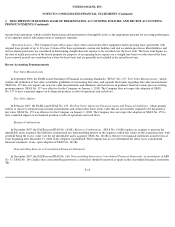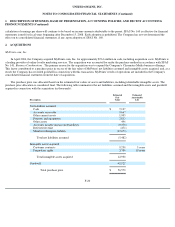Classmates.com 2007 Annual Report Download - page 92
Download and view the complete annual report
Please find page 92 of the 2007 Classmates.com annual report below. You can navigate through the pages in the report by either clicking on the pages listed below, or by using the keyword search tool below to find specific information within the annual report.
UNITED ONLINE, INC.
NOTES TO CONSOLIDATED FINANCIAL STATEMENTS (Continued)
1. DESCRIPTION OF BUSINESS, BASIS OF PRESENTATION, ACCOUNTING POLICIES, AND RECENT ACCOUNTING
PRONOUNCEMENTS (Continued)
whether an other-than-temporary impairment has occurred include: the nature of the investment; whether the decline in fair value is attributable
to specific adverse conditions affecting the investment; the financial condition of the investee; the severity and the duration of the impairment;
and whether the Company has the ability to hold the investment to maturity. When it is determined that an other-than-temporary impairment has
occurred, the investment is written down to its market value at the end of the period in which it is determined that an other-than-temporary
decline has occurred. During the years ended December 31, 2007, 2006 and 2005, the Company did not record any such impairment charges.
Restricted Cash— Restricted cash, which is included in other current assets and other assets in the consolidated balance sheets, consists of
certificates of deposit and, in general, collateralizes the Company's obligations related to standby letters of credit pursuant to certain of the
Company's lease arrangements, and amounts held in escrow related to certain of the Company's merchant services agreements.
Concentrations of Credit and Business Risk— Financial instruments that potentially subject the Company to a concentration of credit risk
primarily consist of cash and cash equivalents, short-term investments and accounts receivable. The Company's accounts receivable are derived
primarily from revenue earned from advertising customers located in the United States and pay accounts. The Company extends credit based
upon an evaluation of the customer's financial condition and, generally, collateral is not required. The Company maintains an allowance for
doubtful accounts receivable based upon the expected collectibility of accounts receivable, and, to date, such losses have been within
management's expectations.
The Company evaluates specific accounts receivable where information exists that the customer may have an inability to meet its financial
obligations. In these cases, based on the best available facts and circumstances, a specific allowance is recorded for that customer against
amounts due to reduce the receivable to the amount that is expected to be collected. These specific allowances are re-evaluated and adjusted as
additional information is received that impacts the amount of the allowance. Also, an allowance is established for all customers based on the
aging of the receivables. If circumstances change (i.e., higher than expected defaults or an unexpected material adverse change in a major
customer's ability to meet its financial obligations), the estimates of the recoverability of amounts due to the Company are adjusted.
At December 31, 2007, one customer comprised approximately 15% of the Company's consolidated accounts receivable balance. At
December 31, 2006, one customer comprised approximately 13% of the Company's consolidated accounts receivable balance. For the years
ended December 31, 2007, 2006 and 2005, the Company did not have any individual customers that comprised more than 10% of total revenues.
At December 31, 2007 and 2006, the Company's cash and cash equivalents were maintained primarily with major financial institutions and
brokerage firms in the United States. Deposits with these institutions and firms generally exceed the amount of insurance provided on such
deposits.
Intangible Assets and Other Long-Lived Assets— The Company accounts for identifiable intangible assets and other long-lived assets in
accordance with SFAS No. 144, Accounting for the Impairment or Disposal of Long-Lived Assets , which addresses financial accounting and
reporting for the impairment and disposition of identifiable intangible assets and other long-lived assets. The Company evaluates the
recoverability of identifiable intangible assets and other long-lived assets, other than indefinite-lived intangible assets, for impairment when
events occur or circumstances change that would indicate that
F-10



